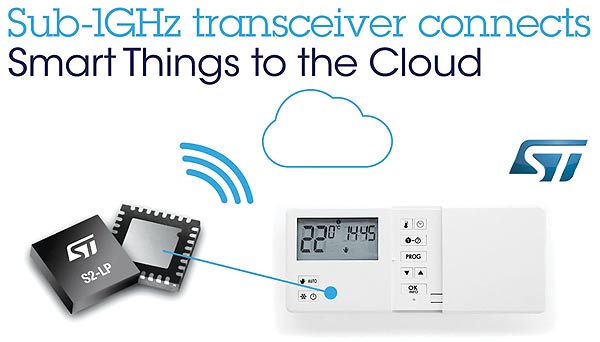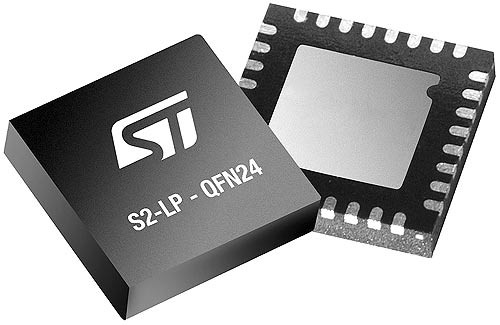 The S2-LP enables objects to be networked and made smart for up to ten years without a battery change. In receiver mode, it consumes just 6.7 mA, while in transmitter mode at 10 dBm, it consumes just 10 mA. In sleep and standby mode, it uses barely 600 and 350 nA respectively.
The S2-LP enables objects to be networked and made smart for up to ten years without a battery change. In receiver mode, it consumes just 6.7 mA, while in transmitter mode at 10 dBm, it consumes just 10 mA. In sleep and standby mode, it uses barely 600 and 350 nA respectively.
“This means that the S2-LP actually has a unique selling point on the market,” explains René Hermanns, Product Manager for Wireless Technology at Rutronik. “Values as low as this are not easy to achieve, and only a few manufacturers have the expertise required for this, for instance in the design of low-energy HF analog circuits or for integration with digital functional segments for the baseband, because energy efficiency must not come at the expense of operational reliability or connection stability – an endeavor in which ST has succeeded with the S2-LP.”
With these features, the transceiver is ideal for networked devices such as alarm systems, monitoring equipment and smart energy meter solutions, as well as for building automation, industrial monitoring and control systems, and systems for lighting, traffic and parking space management in smart city applications. It is especially recommended for any application in which larger distances need to be covered, for instance to integrate outdoor sensors directly into the cloud without the need for a detour via a local gateway.
 “When such sensors are distributed so widely over a larger area and are often hard to reach, the very long battery life also helps to reduce maintenance costs significantly,” René Hermanns notes.
“When such sensors are distributed so widely over a larger area and are often hard to reach, the very long battery life also helps to reduce maintenance costs significantly,” René Hermanns notes.
The programmable radio chip operates in license-free sub-gigahertz frequency bands and can be adapted to the requirements of individual continents accordingly. Examples of popular communication protocols used on the chip include Wireless M-Bus, Sigfox, 6LowPAN and IEEE 802.15.4g, which is suitable for energy management and process control applications and therefore provides a basis for future smart grids.
“This allows the S2-LP to be flexibly deployed for multiple ISM frequency bands while using the globally standard physical layer and everything above it.”
Because it operates on a very narrow band of just a few kilohertz, much less energy is required for data modulation than most other wireless technologies, which usually require between 1 MHz and 20 MHz. With high-power signals of up to 16 dBm, the transceiver also ensures reliable data communication over long distances.
Depending on environmental conditions, its receiver sensitivity of -130 dBm allows for transmission distances of several dozen kilometers, providing large-scale network coverage.
Reliable, Energy-Efficient and Cost-Effective Thanks to Sigfox Integration
“For devices with low data traffic, Sigfox is especially interesting, as it was developed specifically for that purpose. Thanks to the integration of Sigfox in the S2-LP, IoT connectivity with the radio chip is made more reliable, more efficient and more cost-effective. System designers also benefit from the large Sigfox ecosystem,” according to René Hermanns. “While the infrastructure is still in development, many countries in Europe are already covered and Sigfox is cooperating with a number of major network operators to ensure a fast, global roll-out.”
 Sigfox is designed to cover large distances of up to 50 km over open terrain and up to 10 km in built environments, with low data rates of 12 bytes per message and low power consumption. It operates in the sub-GHz frequency band – at 868 MHz in Europe – using narrow-band technology with BPSK for modulation.
Sigfox is designed to cover large distances of up to 50 km over open terrain and up to 10 km in built environments, with low data rates of 12 bytes per message and low power consumption. It operates in the sub-GHz frequency band – at 868 MHz in Europe – using narrow-band technology with BPSK for modulation.
An end device equipped with Sigfox technology supplies its data to Sigfox base stations, which then forward it to the relevant cloud services for processing. From there, the results can be sent for display on any end device.
“A SIM card is not necessary with Sigfox. The usage fee is dependent on how many messages are sent per day. It normally comes to between one and ten euros a year per end device,” Rutronik’s wireless specialist adds.
Depending on the programmed protocol, STMicroelectronics’ new transceiver supports networks with point-to-point, star and mesh topologies, thus offering high flexibility for networked objects.
The S2-LP and the feature-rich Software Development Kit (SDK) are both available from Rutronik, the official franchise partner of STMicroelectronics.
It is already Sigfox-certified, meaning the designs for evaluation purposes and easy prototyping can be connected to the Sigfox network immediately. The SDK is compatible with the STM32 microcontroller family, which is already widespread in the IoT segment. This includes the STM32 development infrastructure with prototype boards and a broad range of software tools and resources.
“But the job isn’t done with the component alone,” explains René Hermanns. “For us, a wireless solution is only ideal if the transmission protocol, the application profiles, the security aspects and certifications are a perfect match for the application in question. This is where we both support and advise our customers in relation to standards, compatibility and consortiums. And of course, the other hardware needs to be well-attuned to it.”
Under Rutronik SMART, developers can find not only wireless components but also sensors, microcontrollers and power management and security solutions for their IoT application. Supported by our cloud platforms with relevant analysis and reporting functionality, we are also able to provide one-stop complete solutions for the interested customer.


